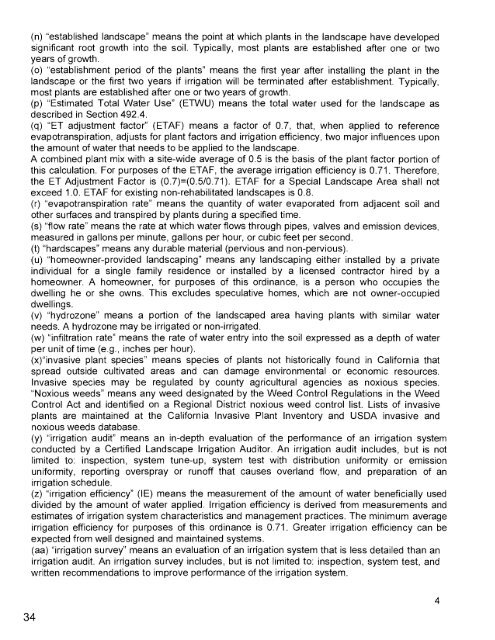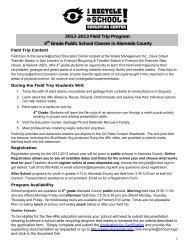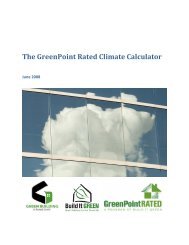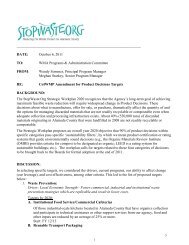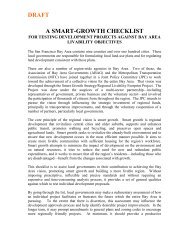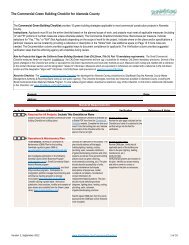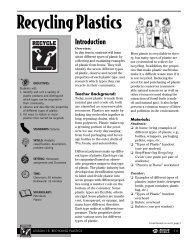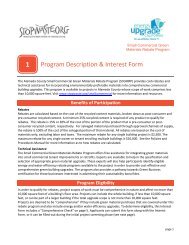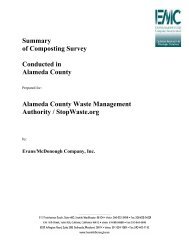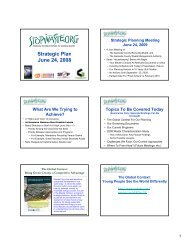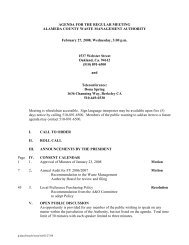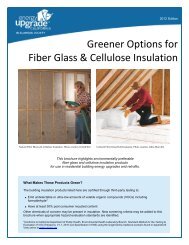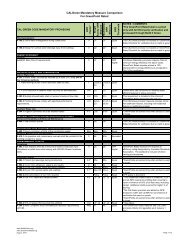Staff Report and WELO Ordinance - StopWaste.Org
Staff Report and WELO Ordinance - StopWaste.Org
Staff Report and WELO Ordinance - StopWaste.Org
- No tags were found...
Create successful ePaper yourself
Turn your PDF publications into a flip-book with our unique Google optimized e-Paper software.
(n) "established l<strong>and</strong>scape" means the point at which plants in the l<strong>and</strong>scape have developedsignificant root growth into the soil. Typically, most plants are established after one or twoyears of growth.(o) "establishment period of the plants" means the first year after installing the plant in thel<strong>and</strong>scape or the first two years if irrigation will be terminated after establishment. Typically,most plants are established after one or two years of growth.(p) "Estimated Total Water Use" (ETWU) means the total water used for the l<strong>and</strong>scape asdescribed in Section 492.4.(q) "ET adjustment factor" (ETAF) means a factor of 0.7, that, when applied to referenceevapotranspiration, adjusts for plant factors <strong>and</strong> irrigation efficiency, two major influences uponthe amount of water that needs to be applied to the l<strong>and</strong>scape.A combined plant mix with a site-wide average of 0.5 is the basis of the plant factor portion ofthis calculation. For purposes of the ETAF, the average irrigation efficiency is 0.71. Therefore,the ET Adjustment Factor is (0.7)=(0.5/0.71). ETAF for a Special L<strong>and</strong>scape Area shall notexceed 1.0. ETAF for existing non-rehabilitated l<strong>and</strong>scapes is 0.8.(r) "evapotranspiration rate" means the quantity of water evaporated from adjacent soil <strong>and</strong>other surfaces <strong>and</strong> transpired by plants during a specified time.(s) "flow rate" means the rate at which water flows through pipes, valves <strong>and</strong> emission devices,measured in gallons per minute, gallons per hour, or cubic feet per second.(t) "hardscapes" means any durable material (pervious <strong>and</strong> non-pervious).(u) "homeowner-provided l<strong>and</strong>scaping" means any l<strong>and</strong>scaping either installed by a privateindividual for a single family residence or installed by a licensed contractor hired by ahomeowner. A homeowner, for purposes of this ordinance, is a person who occupies thedwelling he or she owns. This excludes speculative homes, which are not owner-occupieddwellings.(v) "hydrozone" means a portion of the l<strong>and</strong>scaped area having plants with similar waterneeds. A hydrozone may be irrigated or non-irrigated.(w) "infiltration rate" means the rate of water entry into the soil expressed as a depth of waterper unit of time (e.g., inches per hour).(x)"invasive plant species" means species of plants not historically found in California thatspread outside cultivated areas <strong>and</strong> can damage environmental or economic resources.Invasive species may be regulated by county agricultural agencies as noxious species."Noxious weeds" means any weed designated by the Weed Control Regulations in the WeedControl Act <strong>and</strong> identified on a Regional District noxious weed control list. Lists of invasiveplants are maintained at the California Invasive Plant Inventory <strong>and</strong> USDA invasive <strong>and</strong>noxious weeds database.(y) "irrigation audit" means an in-depth evaluation of the performance of an irrigation systemconducted by a Certified L<strong>and</strong>scape Irrigation Auditor. An irrigation audit includes, but is notlimited to: inspection, system tune-up, system test with distribution uniformity or emissionuniformity, reporting overspray or runoff that causes overl<strong>and</strong> flow, <strong>and</strong> preparation of anirrigation schedule.(z) "irrigation efficiency" (1E) means the measurement of the amount of water beneficially useddivided by the amount of water applied. Irrigation efficiency is derived from measurements <strong>and</strong>estimates of irrigation system characteristics <strong>and</strong> management practices. The minimum averageirrigation efficiency for purposes of this ordinance is 0.71. Greater irrigation efficiency can beexpected from well designed <strong>and</strong> maintained systems.(aa) "irrigation survey" means an evaluation of an irrigation system that is less detailed than anirrigation audit. An irrigation survey includes, but is not limited to: inspection, system test, <strong>and</strong>written recommendations to improve performance of the irrigation system.344


